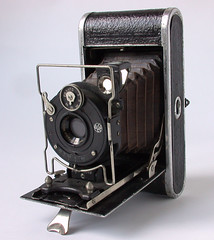Nifcarette
The Nifcarette (ニフカレッテ) is a Japanese 4×6.5 folding camera, made by Nichidoku Shashinki Shōten (predecessor of Minolta) from 1929.
Contents
Origin
The Nifcarette was the first camera made by Nichidoku. The first example was completed at the beginning of March 1929.[1] To design the camera, Tashima Kazuo, the founder of the company, was helped by the German engineers Billy Neumann and Willy Heilemann (who later founded Neumann & Heilemann). Billy Neumann previously worked for Krauss and the Nifcarette was inspired from the Rollette made by this company.[2] The lenses and shutters were imported from Germany and only the body was made in Japan. It is said that the initial production was about fifty units per month.[3]
Name

|
| Nifcarette embossing. (Image rights) |
The Roman spelling appearing on the advertisements and on the camera itself is "Nifcarette".[4] Nifcarette was thus the Roman name used by Nichidoku at the time, and it is used throughout this article. The camera is often called "Nifcalette" by mistake. It would be written and pronounced the same in Japanese, and the name "Nifcalette" is probably the result of an old translation mistake, occurred during the redaction of an early company history after 1945.
"Nifca" comes from Nichidoku Foto Camera.[5] Nichi in Nichidoku means Japan, and it is certainly not coincidental that "Nifca" can also be read as Nippon Foto Camera.
The name Nifcarette was certainly inspired by the names of some German cameras of the time, like the Icarette, Cocarette and Rollette, as well as the Japanese Pearlette.
General description
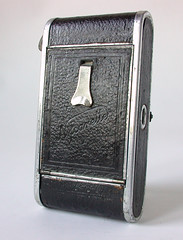 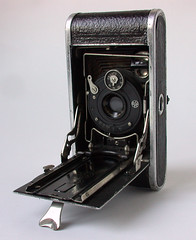 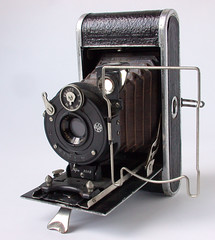
|
| Nifcarette B no.3089, Pronto shutter, Anastigmat Wekar 75mm f.6.3 lens. Pictures courtesy of A. Apra. (Image rights) |

|
| Advance key and folding bed release. (Image rights) |
The Nifcarette is a vertical folder, taking 4×6.5cm exposures on 127 film. It is not self-erecting: the front standard needs to be manually pulled out after opening the bed. There is a folding brilliant finder attached to the front standard, and sometimes a hinged wireframe too. The word Nifca and the serial number are normally engraved on a small plate screwed to the base of the front standard.
There is a winding key at the top right (as seen by the photographer holding the camera vertically), and the folding bed release is placed next to it. The film advance is controlled by a single uncovered red window in the middle of the back. This red window is surrounded by a circular metal frame, which extends to the side and contains the retracting bead for the wireframe finder on the cameras originally equipped with such device.
 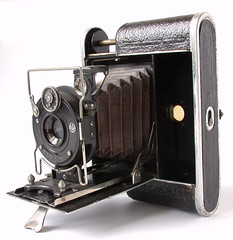 
|
| Nifcarette B no.3089, Pronto shutter, Anastigmat Wekar 75mm f.6.3 lens. Pictures courtesy of A. Apra. (Image rights) |
 
|
| Locking button (A and Z). (Image rights) |
The side plate and the film chamber with the bellows assembly and spool holders slides out of the body shell when the camera is opened, as on the Krauss Rollette. The camera is locked in closed position by a small sliding button on one side of the body, with A and Z indications (for Auf and Zu, i.e. open and closed in German).

|
| Nichidoku logo. (Image rights) |
The name Nifcarette is embossed in the leather covering on the folding bed.[6] The logo of Nichidoku is engraved between the lens rails, with the letters N, D, PH and Co assembled inside a circle, surely for Nichi Doku Photo Company. (This logo was strongly inspired from that of G. A. Krauss found on some versions of the Rollette.)
Versions
Naming
Many sources say that the Nifcarette was sold in three models, called Nifcarette A, B and D.[7] The names "Nifcarette A" and "Nifcarette B" are confirmed by original advertisements in Asahi Camera, respectively dated May and September 1930.[8] The pictured cameras show important differences in the focusing mechanism and in the layout of the front standard, and the names "A" and "B" clearly refer to two different body versions. The name "Nifcarette D" certainly applies to the cheaper body version, but no original document has yet been observed to confirm this name.[9] It is not known if there was a model C.[10]
Lens and shutter list

|
| Anastigmat Wekar f/6.3 and Pronto. (Image rights) |
The chronology compiled by Chiyoda Kōgaku Seikō (predecessor of Minolta) and published in Shashin Kōgyō in September 1958 gives the following list of lens and shutter combinations:[11]
- Xenar f/4.5, Compur (1–300);
- Wekar Double Anastigmat f/4.5, Compur (1–300);
- Wekar Anastigmat f/4.5, Ibsor (1–125);
- Wekar Anastigmat f/6.3, Ibsor (1–125);
- Wekar Anastigmat f/6.3, Pronto[12] (25–100);
- Aplanat f/8, Pronto[12] (25–100);
- Aplanat f/8, Vario (25–100).
The Xenar lens was supplied by Schneider and the Wekar lenses were supplied by Kenngott.
The original documents observed so far are insufficient to assign these combinations precisely to the body versions. Sources agree that the Aplanat f/8 lens corresponds to the Nifcarette D.[13] The other combinations presumably apply to the Nifcarette A and B; of course the most expensive combinations tended to be mounted on the most sophisticated Nifcarette A.
The Nifcarette A

|
| Nifcarette A no.1370, Xenar f/4.5 lens, rim-set Compur. From Shashin Kōgyō September 1958. (Image rights) |
The Nifcarette A has a focusing worm-screw sunken in the folding bed, to the photographer's right, moving the lens standard back and forth on precisely machined rails. This focusing device is copied on the Goerz Roll-Tenax.[14] The lens standard has two handles at the bottom, used to pull it out after opening the folding bed. The body edges have a metal finish and there is no wireframe finder.
This model appears in the May 1930 advertisement in Asahi Camera, where its name is given in Roman letters ("Nifcarette Mod. A") and in katakana script (ニフカレッテ・モデルA).[15] The picture is heavily retouched; it was used alone by the company in an early historical article, and is reproduced on the right.[16] The pictured camera has body no.1370, a Schneider Xenar 7.5cm f/4.5 lens and a rim-set Compur shutter (T, B, 1–300).
It is said that the version with Xenar and rim-set Compur was initially priced at ¥75 in 1929, and that advertisements dated 1930 give the price of ¥90.[17] Other lenses and shutters were reportedly available, presumably in the following combinations:[18]
- Wekar f/4.5, dial-set Compur;
- Wekar f/4.5, Ibsor;
- Wekar f/6.3, Ibsor;
- Wekar f/6.3, Pronto (reportedly priced at ¥45).
Some sources mention a Heliostar lens and Koilos shutter combination, mainly because the surviving Nifcarette B having such equipment is misidentified as a Nifcarette A;[19] this combination was probably not originally advertised on any Nifcarette model.
The only surviving example of the Nifcarette A observed so far is pictured in Awano.[20] Its body number is hardly legible as 1404. It has a Wekar-Anastigmat f/6.3 lens and a dial-set Pronto shutter.
The Nifcarette B
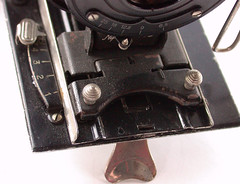 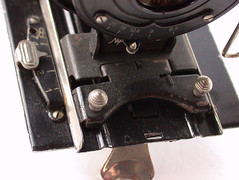 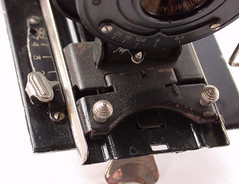
|
| Focusing mechanism of the Nifcarette B. Pictures courtesy of A. Apra. (Image rights) |
The Nifcarette B has a focusing lever on the right instead of a worm-screw. The lens rails are simpler and made of folded sheet metal. The front standard is pulled out by two pins; these are mounted on a small plate hinged to the bottom of the lens standard itself and retracting together with the folding bed when the camera is closed. The wireframe finder seems to be part of the standard equipment, in addition to the brilliant finder; it has an indent at the bottom to allow the pulling pins to retract.
  
|
| Base of the front standard, extending and retracting inside the body. Pictures courtesy of A. Apra. (Image rights) |
This model appears in the September 1930 advertisement in Asahi Camera, where the name "Nifcarette B" is given in Japanese characters (ニフカレッテB型).[21] The advertisement gives a choice of two versions:
- Ibsor shutter (T, B, 1–100), Anastigmat f/6.3 three-element lens, ¥42;
- Pronto shutter, ¥33.
The pictured camera has metal body edges and a wireframe finder. Its shutter is an Ibsor; the words IBSOR and DRP are inscribed at the top of the shutter plate, and NIFCAPHOTO is faintly legible on the speed-setting dial,
The January 1931 advertisement in Asahi Camera lists the "Nifcarette B" (ニフカレッテB) and shows the same picture, but gives no detail.[22]
One source, certainly based on some early historical account by the Minolta company, says that the Nifcarette B was available in four versions:[23]
Another source mentions Vario shutters in addition to the above options.[24] It is said that the price was ¥33 to ¥60.[25]
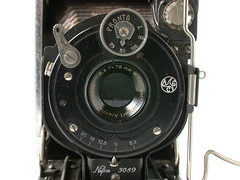  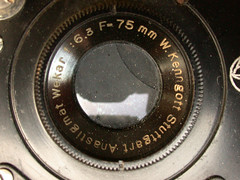
|
| Nifcarette B no.3089, Pronto shutter, Anastigmat Wekar 75mm f.6.3 lens. (Image rights) |
Pictures of at least four actual examples have been observed. The example pictured in this article has body no.3089.[26] It has metal finished body edges and a wireframe finder, the same as in the advertisements. The shutter is a dial-set Pronto giving 25, 50, 100, B, T speeds; the name PRONTO is inscribed in the speed-setting dial and the front plate has the AGC logo of Gauthier. The lens is engraved W. Kenngott Stuttgart Anastigmat Wekar 1:6.3 F=75mm and has no serial number.
Other two examples are twins, with body no.3773 and 3774.[27] The better known is no.3774, which was belonging to the Minolta Gallery in the 1980s;[28] it is certainly the example that was displayed in the JCII exhibition about Konica and Minolta in 2005. Today (2008) it is probably the property of Konica Minolta or Sony. The two cameras have metal body edges and a wireframe finder. They have the same dial-set Pronto shutter as the previous camera. The lens is a Wekar f/6.3 on both, but the lens engraving differs: on the available pictures of no.3773, it is faintly legible as W. Kenngott Stuttgart Wekar–Anastigmat 6.3 7.5cm with no lens number, whereas it is Wekar–Anastigmat 1:6.3 f=75mm Nr.3782 with no mention of the lens maker on no.3774.[29]
The fourth example is pictured in many sources, where it is sometimes misidentified as a "Nifcarette A".[30] It has a Heliostar f/6.3 lens, engraved Heliostar Anastigmat München 1:6.3 f=75mm Nr75004, whose origin is unclear (see the corresponding page), and a dial-set Koilos shutter giving 25, 50, 100, B, T speeds. The name KOILOS is inscribed on the cover of the speed setting wheel; this cover extends down above the lens and also has the words Nifca Photo. There is a hole under the lens, certainly for a thread and needle release (a crude replacement for a self-timer). The nameplate with the serial number is missing: the hole for the attaching screw is visible at the bottom of the lens standard. The wireframe is absent, perhaps because it is missing too. The body edges are black painted, and the advance key differs from that of the other Nifcarette.
The Nifcarette D
The Nifcarette D reportedly corresponds to a simpler version, with a lens standard back and forth by hand for focusing, and an Aplanat f/8 lens.[31] It is said that two versions were offered: with a Pronto shutter for ¥20 and with a Vario shutter for ¥18.[32]
Pictures of at least two surviving examples with hand-driven focusing have been observed. These two examples present important differences in the shape of the lens standard. It is not known for sure if either one of the two, or both, correspond to the Nifcarette D. The more elaborate example might correspond to an hypothetical "Nifcarette C", whereas the simpler one might be a Nifcarette D, but this is mere guesswork.
One of them is shown in this page at Yone Lab; its body number is legible as 5019. It has metal body edges and is not equipped with a wireframe finder. Its lens standard is similar to that of the Nifcarette B; there is no focusing lever but an index moving along a black distance scale on the photographer's left. The shutter is a dial-set Pronto, similar to that of no.3089, 3773 and 3774. The lens has f/8 to f/32 aperture settings and is reportedly engraved "Wekar-Aplanat".[33]
The other example is pictured in various sources.[34] Its body edges are black painted, and no wireframe finder is visible. The lens standard differs from that of no.5019; it does not have the hinged plate with the two pulling pins, its focusing index has a different shape, and the whole assembly is in bare metal finish. The plate displaying the maker's short name and the serial number is absent, and was perhaps never fitted (no mounting hole is visible). The shutter is a dial-set Vario giving 25, 50, 100, B, T speeds; the name VARIO is inscribed on the setting dial and no other marking is visible. The lens is reported as an Aplanat 75mm f/8; on the available pictures, the marking is faintly legible as Aplanat 1:8 F=75mm with no mention of the name "Wekar".[35]
The Sirius Bebe
The Sirius Bebe (シリウスベベー) is a dual-format evolution of the Nifcarette B, taking 4×6.5cm and 3×4cm exposures. The back is accordingly modified, with two hexagonal red windows. The wireframe finder is replaced by a folding sportsfinder on the side, above the back opening button, with two bars indicating the field of view for 3×4cm pictures; this finder is very similar to that mounted on the later Minolta Vest. There is an advance knob instead of a key, and the body edges and standing leg are black painted. The front standard and focusing system are the same as on the Nifcarette B. The name Sirius Bebe is embossed in the leather of the folding bed, at the same place as the Nifcarette logo of the previous models.
The Sirius Bebe was forgotten by the company in its own historical accounts, and does not appear in the September 1958 chronological table cited above;[36] this certainly explains why it is mentioned by very few sources (all of them Japanese). These suggest that the Nifcarette was renamed Sirius Bebe after the company changed its name from Nichidoku Shashinki Shōten to Molta Gōshi-gaisha in 1931.[37] However there was some overlap of the serial numbers between the two models (see below), probably indicating that the new model did not directly replace the Nifcarette, but was added to the range as an evolved version.
An original leaflet for the Sirius Bebe is reproduced in an article by Awano.[38] It presents the camera and also serves as a bilingual user manual (in English and Japanese). The early Molta logo and the words "Molta Camera Works" appear on the front page; the latter is surely a dummy name. The camera is described as having a Heliostar Anastigmat f/6.3 lens and a Koilos shutter, and the weight is given as 340g. The pictured camera has a black advance knob, and the Koilos shutter still has the small Nifca Photo nameplate, despite the new Molta company name. It is said that the camera was supplied with a soft release, a Molta exposure table and a user manual (perhaps the very document itself); no price is given. It is reported elsewhere that the Sirius Bebe appears in an original catalogue with a Heliostar f/4.5 lens; however this might be a confusion with the previous document.[39]
At least two surviving examples of the Sirius Bebe are known. The better known camera has a dial-set Compur shutter and a Doppel-Anastigmat Wekar 7.5cm f/4.5 lens by Kenngott, with the aperture scale at the top.[40] The advance knob has a metal finish, unlike that pictured in the user manual. The name Nifca appears at the bottom of the front standard, and the body number is 4821. This is lower than no.5019 found on a Nifcarette. A clamp is visible on the side of the lens standard to attach a wireframe, certainly because parts initially made for the Nifcarette B were used to assemble this camera.
The other example has a different shutter type (probably a Pronto), a black advance knob, and no wireframe attachment at all.[41] The small size of the only available picture does not allow to draw any further.
Notes
- ↑ The date is given in Tashima, Watakushi no rirekisho, quoted in Tanimura, p.96 of Kurashikku Kamera Senka no.12: 昭和4年の3月初め、ついに1台の写真機が完成した. This information is repeated in Awano, p.6 of the same magazine. The fifty-year history Minolta 50-nen no ayumi, p.5, also says that the first camera was completed in March 1929; in this document, the table on p.65 gives the price of ¥18–20 for the model released in March 1929, but this is perhaps a confusion.
- ↑ Neumann worked for Krauss: Tashima, Watakushi no rirekisho, quoted in Tanimura, p.96 of Kurashikku Kamera Senka no.12.
- ↑ Kikan Classic Camera 14, p.14.
- ↑ Advertisements reproduced in Hagiya, p.9 of Kurashikku Kamera Senka no.12. The markings on the camera itself are visible in this article and in this page at Yone Lab.
- ↑ Taniguchi, p.276 of Shashin Kōgyō no.77 (article also reproduced in Tanimura, p.8 of Camera Collectors' News no.116), Francesch, p.17, Nifcarette page of the Konica Minolta website.
- ↑ See the third picture in this page of the Yone Lab website.
- ↑ Awano, p.13 of Kurashikku Kamera Senka no.12, Francesch, p.69, McKeown, p.671.
- ↑ Advertisements reproduced in Hagiya, p.9 of Kurashikku Kamera Senka no.12.
- ↑ Awano, p.13 of Kurashikku Kamera Senka no.12, Francesch, p.69.
- ↑ Awano, p.13 of Kurashikku Kamera Senka no.12, mentions the existence of the model "C" as unsure. The Rulex shutter, a later product by Neumann & Heilemann, is known to exist only in A, B and D versions; this was perhaps because the letter "C" is pronounced "shī" by Japanese speakers, a sound reminding the word shi meaning "death".
- ↑ "Hensen kamera ichiran-pyō", p.295 of Shashin Kōgyō no.77, also reproduced in this Flickr page by Rebollo_fr.
- ↑ 12.0 12.1 The table has Prontor (プロンター), clearly a mistake for Pronto (プロント). The same mistake is done in Taniguchi, p.275 of Shashin Kōgyō no.77 (article also reproduced in Tanimura, p.8 of Camera Collectors' News no.116).
- ↑ Awano, p.13 of Kurashikku Kamera Senka no.12, Francesch, p.69.
- ↑ See for example the Roll-Tenax pictured in this page at ksmt.com.
- ↑ Advertisement reproduced in Hagiya, p.9 of Kurashikku Kamera Senka no.12. The fifty-year history Minolta 50-nen no ayumi, p.65, says that the Nifcarette A was released in June 1930 but this is inaccurate.
- ↑ Picture reproduced in Taniguchi, p.275 of Shashin Kōgyō no.77 (article also reproduced in Tanimura, p.8 of Camera Collectors' News no.116), in Scheibel, p.8, and in Lewis, p.49.
- ↑ Awano, p.6 of Kurashikku Kamera Senka no.12. The initial price of ¥75 is also mentioned for this version in Taniguchi, p.275 of Shashin Kōgyō no.77 (article also reproduced in Tanimura, p.8 of Camera Collectors' News no.116). Francesch, p.17, Scheibel, p.9, and Kikan Classic Camera 14, p.14, mention the price of ¥75 for the most expensive version of the Nifcarette.
- ↑ Awano, p.13 of Kurashikku Kamera Senka no.12, mentions Xenar f/4.5, Wekar f/4.5 and f/6.3 lenses, dial-set Compur, Ibsor and Pronto shutters, without assigning precise combinations. Francesch lists the first three combinations on p.69, and also mentions that with Wekar f/6.3 lens and Pronto shutter on p.17. The price of ¥45 for the cheaper combination is reported in Minolta 50-nen no ayumi, p.65, and in Francesch, p.17.
- ↑ Francesch, p.69.
- ↑ Awano, p.13 of Kurashikku Kamera Senka no.12. Francesch, p.68, wrongly identifies the surviving example with Heliostar and Koilos as a Nifcarette A.
- ↑ Advertisement reproduced in Hagiya, p.9 of Kurashikku Kamera Senka no.12. The fifty-year history Minolta 50-nen no ayumi, p.65, says that the Nifcarette B was released in September 1930, perhaps after this advertisement.
- ↑ Advertisement reproduced in Awano, p.6 of Kurashikku Kamera Senka no.12.
- ↑ Francesch, p.69.
- ↑ Awano, p.13 of Kurashikku Kamera Senka no.12, mentions Wekar f/4.5 and f/6.3 lenses, Compur, Ibsor, Pronto and Vario shutters, without assigning precise combinations.
- ↑ The price range is given as ¥33–60 in the fifty-year history Minolta 50-nen no ayumi, p.65; this is consistent with the price of ¥33 for the Pronto version in the September 1930 advertisement in Asahi Camera. Francesch, p.17, says ¥35–60 instead, perhaps as a result of a misprint.
- ↑ The exact same camera was also pictured in a page at Ishinoya's blog (archived).
- ↑ No.3773 is pictured in Eimukku 735 Minolta, pp.4 and 130–2. No.3774 is pictured in Francesch, p.68 and cover page, in Sugiyama, item 1180, in Kikan Classic Camera 14, p.14, in this page of the Konica Minolta website and in various websites copying the same picture.
- ↑ Sugiyama, item 1180.
- ↑ Sugiyama, item 1180, says "Weker" but this is a typo.
- ↑ Example pictured in Francesch, p.68, in Scheibel, p.8 and cover page, in McKeown, p.671, in Baird, p.39, and in this page at Infocam (archived).
- ↑ Awano, p.13 of Kurashikku Kamera Senka no.12.
- ↑ Pronto and Vario shutters are mentioned in Awano, p.13 of Kurashikku Kamera Senka no.12, and in Francesch, p.69. The prices of ¥18 and ¥20 are mentioned in Francesch, p.17. Scheibel, p.9, and Kikan Classic Camera 14, p.14, say ¥18 for the cheapest version.
- ↑ "Wekar-Aplanat": this page at Yone Lab.
- ↑ Example pictured in Francesch, p.28, in Sugiyama, item 1179 (where it is said to belong to Y. Saji), and in Zaisu Ikon, p.7 of Camera Collectors' News no.63 (Zaisu Ikon is certainly a pseudonym for Y. Saji).
- ↑ Aplanat 75mm f/8 or Aplanat f/8: Francesch, p.69, Sugiyama, item 1179, Zaisu Ikon, p.7 of Camera Collectors' News no.63.
- ↑ "Hensen kamera ichiran-pyō", p.295 of Shashin Kōgyō no.77, also reproduced in this Flickr page by Rebollo_fr.
- ↑ Renamed after the company changed its name: Awano, p.2 of Camera Collectors' News no.128 and pp.6 and 13 of Kurashikku Kamera Senka no.12, Eimukku 735 Minolta, p.133.
- ↑ Leaflet reproduced in Awano, pp.4–5 of Camera Collectors' News no.128.
- ↑ Awano, p.13 of Kurashikku Kamera Senka no.12.
- ↑ Example pictured by Awano in Camera Collectors' News no.128 and on p.13 of Kurashikku Kamera Senka no.12.
- ↑ Example pictured in Eimukku 735 Minolta, pp.131 and 133.
Bibliography
Early historical accounts
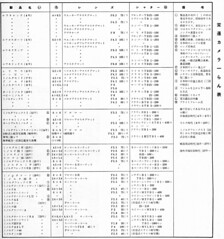
|
| Chronology in Shashin Kōgyō September 1958. (Image rights) |
- Shashin Kōgyō no.77 (September 1958). "Hensen kamera ichiran-pyō" (変遷カメラ一らん表, Table of camera evolution.) P.295. (This is a chronology of Minolta cameras from the Nifcarette onwards. This document is reproduced in this Flickr page by Rebollo_fr.)
- Taniguchi Masao (谷口匡男), from the commercial department (営業部) of Chiyoda Kōgaku Seikō. "Minoruta kamera no sakujitsu, konnichi" (ミノルタ・カメラの昨日、今日, Minolta cameras, yesterday and today). In Shashin Kōgyō no.77 (September 1958). Pp.275–9. (The two first pages of this document, on pre-1937 cameras, are also reproduced in Tanimura, p.8 of Camera Collectors' News no.116.)
Recent sources
- Awano Mikio (粟野幹男). "Minoruta ryakushi" (ミノルタ略史, Minolta short history). Kamera Rebyū: Kurashikku Kamera Senka (カメラレビュー クラシックカメラ専科) / Camera Review: All about Historical Cameras no.12, October 1988. No ISBN number. Minoruta kamera no subete (ミノルタカメラのすべて, special issue on Minolta). Pp.6–8.
- Awano Mikio (粟野幹男). "Senzen no Minoruta kamera" (戦前のミノルタカメラ, Prewar Minolta cameras). Kamera Rebyū: Kurashikku Kamera Senka (カメラレビュー クラシックカメラ専科) / Camera Review: All about Historical Cameras no.12, October 1988. No ISBN number. Minoruta kamera no subete (ミノルタカメラのすべて, special issue on Minolta). Pp.13–7.
- Awano Mikio (粟野幹男). "Shiriusu Bebē" (シリウスベベー, Sirius Bebe). In Camera Collectors' News no.128 (February 1988). Nishinomiya: Camera Collectors News-sha.
- Baird, John R. The Japanese Camera. Yakima, WA: Historical Camera Publications, 1990. ISBN 1-879561-02-6. Pp.37–9.
- Eimukku 735, Manyuaru Kamera Shirīzu 15 (エイムック735・マニュアルカメラシリーズ15). Minolta: Minoruta kamera no subete (Minolta:ミノルタカメラのすべて, Minolta: all of Minolta cameras). Tokyo: Ei Shuppansha, 2003. ISBN 4-87099-923-4. "Jabara-shiki kamera no kiseki" (蛇腹式カメラの軌跡", Evolution of folding cameras). Pp.130–2. (See also the picture on p.4.)
- Francesch, Dominique and Jean-Paul. Histoire de l'appareil photographique Minolta de 1929 à 1985. Paris: Dessain et Tolra, 1985. ISBN 2-249-27685-4. Pp.17–8, 67–9 and 263.
- Hagiya Takeshi (萩谷剛). "Kōkoku ni miru Minoruta kamera no rekishi" (広告に見るミノルタカメラの歴史, Minolta camera history seen through the advertisements). Kamera Rebyū: Kurashikku Kamera Senka (カメラレビュー クラシックカメラ専科) / Camera Review: All about Historical Cameras no.12, October 1988. No ISBN number. Minoruta kamera no subete (ミノルタカメラのすべて, special issue on Minolta). Pp.9–12.
- Kikan Classic Camera 14 Tokushū: Minoruta Rokkōru densetsu (季刊クラシックカメラ14・特集ミノルタロッコール伝説, special: Minolta Rokkor legend). Tokyo: Futabasha, 2002. ISBN 4-575-47427-4. P.14.
- Lewis, Gordon, ed. The History of the Japanese Camera. Rochester, N.Y.: George Eastman House, International Museum of Photography & Film, 1991. ISBN 0-935398-17-1 (paper), 0-935398-16-3 (hard). P.49.
- McKeown, James M. and Joan C. McKeown's Price Guide to Antique and Classic Cameras, 12th Edition, 2005-2006. USA, Centennial Photo Service, 2004. ISBN 0-931838-40-1 (hardcover). ISBN 0-931838-41-X (softcover). P.671.
- Minolta Camera. Minolta 50-nen no ayumi (Minolta・50年のあゆみ, Minolta 50-year history). November 1978. Pp.5 and 65.
- Scheibel, Anni Rita and Joseph. 70 Jahre Minolta Kameratechnik — Von der Nifcalette bis zur Dynax 9. Stuttgart: Lindemanns Verlag, 3rd edition, 1999. ISBN 3-89506-191-3. Pp.8–9.
- Sugiyama, Kōichi (杉山浩一); Naoi, Hiroaki (直井浩明); Bullock, John R. The Collector's Guide to Japanese Cameras. 国産カメラ図鑑 (Kokusan kamera zukan). Tokyo: Asahi Sonorama, 1985. ISBN 4-257-03187-5. Items 1179–80.
- Tanimura Yoshihiko (谷村吉彦). "Neumann & Heilemann: kieta ashiato, Minoruta setsuritsu to sono ato no karera wo otte" (Neumann & Heilemann 消えた足跡・ミノルタ設立とその後の彼等を追って, On the traces of Neumann & Heilemann at the founding of Minolta and afterwards.) Kamera Rebyū: Kurashikku Kamera Senka (カメラレビュー クラシックカメラ専科) / Camera Review: All about Historical Cameras no.12, October 1988. No ISBN number. Minoruta kamera no subete (ミノルタカメラのすべて, special issue on Minolta). Pp.96–9. (Quoting Tashima's book Watakushi no rirekisho.)
- Tanimura Yoshihiko (谷村吉彦). "Semi Minoruta I-gata to II-gata" (セミミノルタⅠ型とⅡ型, Semi Minolta I and II). In Camera Collectors' News no.116 (February 1987). Nishinomiya: Camera Collectors News-sha. (Contains a reproduction of the articles in Shashin Kōgyō no.77, a discussion of the release dates and no other information on the Nifcarette.)
- Zaisu Ikon (座椅子遺恨, probably a pseudonym of Y. Saji). "Besuto sanka (M–O)" (ベスト讃歌[M–O], Vest hymn [M–O]). In Camera Collectors' News no.63 (September 1982). Nishinomiya: Camera Collectors News-sha. P.7.
Links
In English:
- Nifcarette B (no.3774, Pronto, Wekar f/6.3) in the 70th anniversary Minolta poster, reproduced at Photoclub Alpha
- Nifcarette B (no.3774, Pronto, Wekar f/6.3) among Minolta folding cameras and Minolta cameras using 127 film at Minman
In Japanese:
- Nifcarette B (see 1929) (no.3774, Pronto, Wekar f/6.3) in the Konica Minolta official history site
- Nifcarette D (Pronto, Wekar-Aplanat f/8) and specs at the Yone Lab website
In Chinese:
- Nifcarette B (Koilos, Heliostar f/6.3, lens no.75004) in a Chinese webpage
| Nifca, Molta and Chiyoda prewar and wartime cameras () | |
|---|---|
| folding plate cameras | |
| Nifcaklapp | Nifcasport | Sirius | Arcadia | Lomax | Eaton | Happy | |
| folding rollfilm cameras | telescopic bakelite cameras |
| Nifcarette | Sirius Bebe | Semi Minolta | Auto Semi Minolta | Minolta Vest | Baby Minolta | Minolta Six |
| strut-folding cameras | TLR cameras |
| Nifca-Dox | Minolta | Auto Minolta | Auto Press Minolta | Minoltaflex | Minoltaflex Automat | Minoltaflex military prototype |
